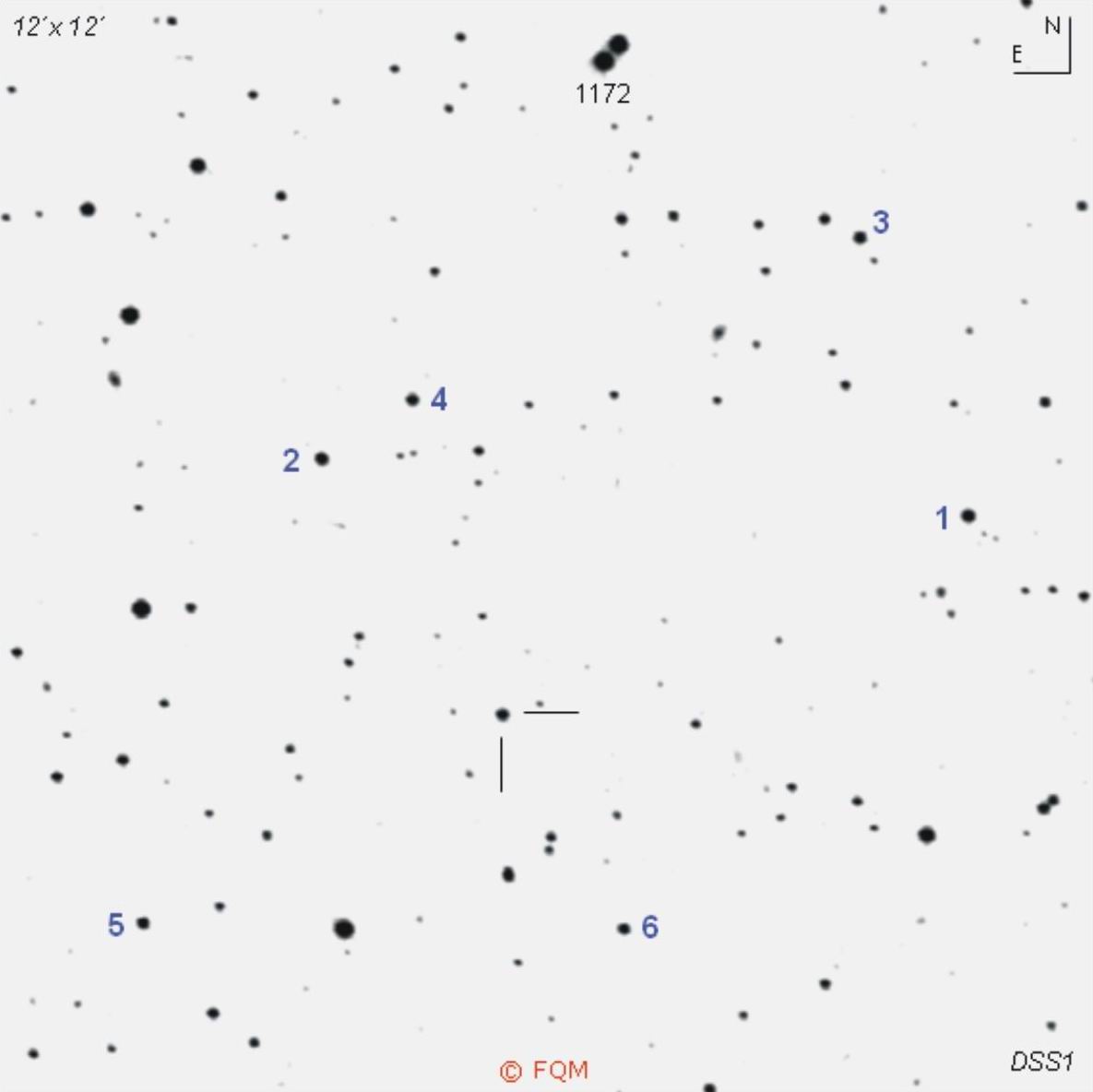
| Frankfurt Quasar Monitoring |
| HS 0624+6907 |
| Cross-Identifications |
QSO
B0624+6907, QSO J0630+6905, 0624+691 RX J06300+6904, 2MASS J06300250+6905039 GALEXASC J063002.55+690504.3 [VCV2006] J063002.6+690503 |
| Equat. coordinates | RA 06 30 02.6 DE +69 05 03 (J2000) |
| Constellation | Camelopardalis |
| Type | QSO |
| Redshift (1) (2) |
z=0.370 |
|
Distance (2) (3) |
1398 Mpc |
| Total mag range (mv) (4) (5) | 14.02 - 14.5 |
| Catalog Magnitude (1) | 14.16 |
| Absolute Magnitude (1) | -27.2 MB |
| Light Travel-Time (2) | 3.898 × 109 yrs |

Comparison stars
| star | B | V |
| 1 | 14.548 (0.129) |
13.901 (0.064) |
| 2 | 15.015 (0.138) |
14.239 (0.060) |
| 3 | 15.038 (0.123) | 14.381 (0.078) |
| 4 |
15.117 (0.130) | 14.545 (0.069) |
| 5 |
15.528 (0.221) | 14.636 (0.075) |
| 6 |
15.770 (0.180) | 15.035 (0.080) |

| HS
0624+6907
is a
bright quasar in Camelopardalis. Its position lies about 2.1° W of 43
Cam, and 1° E of L Cam (HD 42818). HS 0624+6907 was discovered in 1989
during the Hamburg Quasar Survey (HS). This survey was carried out by the
80-cm Schmidt-Telescope at Calar Alto
Observatory, equipped with an objective prism. The newly found
point source was immediately identified as a
quasar by follow-up spectral analysis. With an
apparent brightness of
v=14.2 m, this quasar was the second brightest (!) ever
discovered in the optical band pass. Together with quasar KUV 18217+6419 (which was
equally bright at the time of discovery), HS 0624+6907 was
only surpassed by famous quasar 3C
273. Quasar HS 0624+6907 is a small amplitude variable object ranging between 14.0 and 14.5 mag. Due to its brightness, this quasar is an easy task for visual observers with telescopes of 8- to 10-inch of aperture. The object appears stellar even with large apertures. This comes without surprise, considering the quasars large cosmological distance of nearly 4×109 light-years. Without a go-to mount, tracking down quasar HS 0624+6907 is a little tricky, as it lies in a region lack of bright stars for easy starhopping. CCD observers, as well as visual observers, shall use the comparison stars given above. ____________
Only
7´N of quasar HS
0624+6907,
you find a faint but nice double star, consisting of an 11.72-mag
primary and a 12.15-mag companion, separated by 14.7" (see the double
on top of
the finding chart). Both components share the same proper motion. In
addition, this double is a good orientation mark to locate the quasar
position
in the eyepiece or CCD frame. When observing HS 0624+6907, do not forget to visit bright spiral galaxy NGC 2403, only 7° SE. NGC:2403 is a face-on type SBc spiral and a member of the M 81-galaxy group. In case you look for another bright interesting blazar I recommend S5 0716+71, a bright and violently variable BL Lac object, about 5° NE. |
| Bade, W., Witt, P. 1989, SuW 5/89, 283; Automatische Suche nach Quasaren. Bowen, D.V., Osmer, S.J., Blades, J.C., et al. 1994, AJ, 107, 461; Hubble Space Telescope faint object spectrograph QSO absorption snapshot survey (ABSNA). Groote, D., Heber, U., Jordan, S. 1989, A&A, 223, L1; Discovery of Two Bright Low-Redshift Quasars by the Hamburg Quasar Survey. Karge, S.; Helle Quasare für 8- bis 10-Zoll Teleskope. Ein Beobachtungsführer zur visuellen Beobachtung von Quasaren und BL Lacertae Objekten; Frankfurt 2005. Reimers, D., Hopp, U., et al. 1995, A&A, 303, 449; Multiwavelength observations of the bright QSO HS 0624+6907. Steinicke, W.; Beobachtungsliste für helle Quasare; Umkirch 1999. Véron-Cetty, M.-P., Véron, P. 2001, A&A 374, 92; A Catalogue of Quasars and Active Nuclei: 10th edition. Véron-Cetty, M.-P., Véron, P. 2003, A&A 412, 399; A Catalogue of Quasars and Active Nuclei: 11th edition. Véron-Cetty, M.-P., Véron, P. 2006, A&A 455, 776; A Catalogue of Quasars and Active Nuclei: 12th edition. Véron-Cetty, M.-P., Véron, P. 2010, A&A 518, 10; A Catalogue of Quasars and Active Nuclei: 13th edition. Wenzel, K. 2001, Interstellarum 16, 53; QdQ: HS 0624+6907. |
| Links: Hamburg Quasar Monitoring APASS |